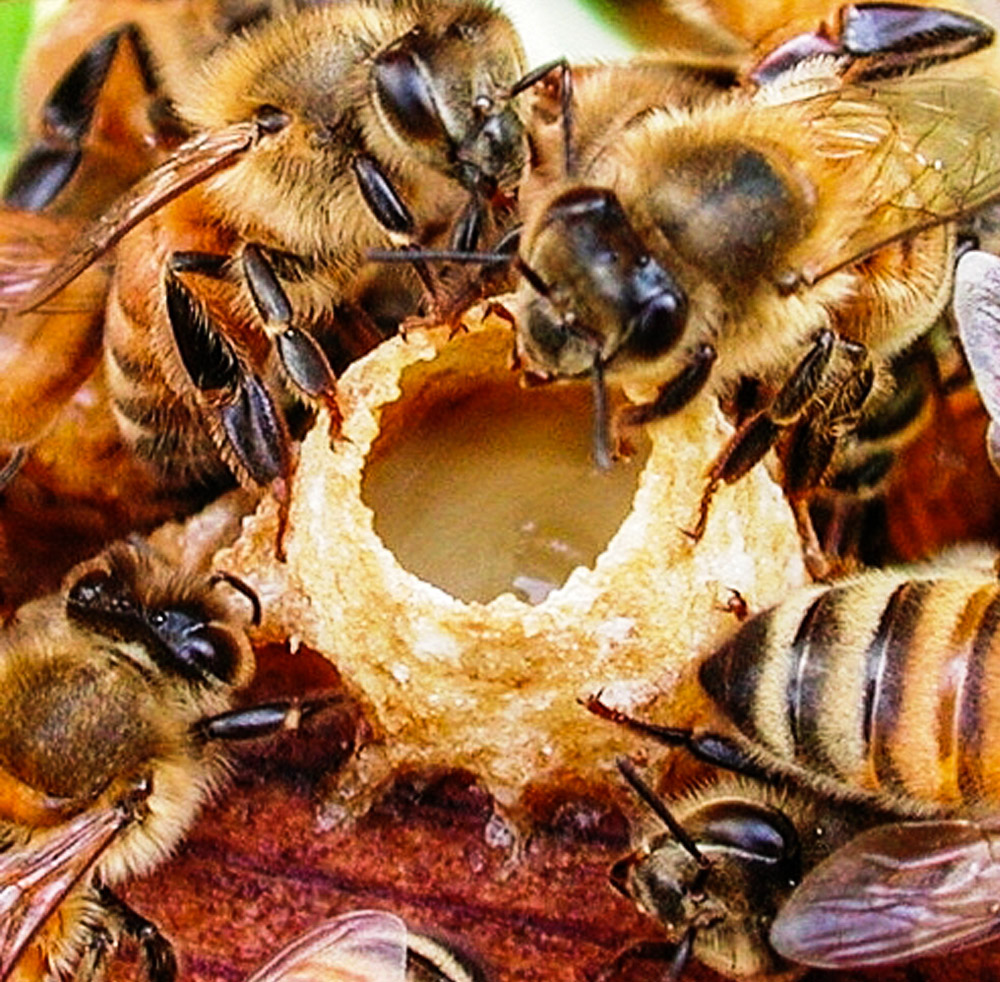Royal Jelly

About Royal Jelly
The young nurse bees make royal jelly, it is a secretion from glands on the tops of their heads. For 2-3 days, royal jelly is the only food given to all young larvae in their maturation process, while for the queen larvae, it is the specific food for their whole life period. During the 3 days in which the worker bee larvae are fed on royal jelly, they reach the maximum development; their weight multiplies about 250 times. The queen (fed only on royal jelly for her entire life) reaches maturity 5 days earlier than the worker bees; and, when she is fully grown, her weight is double that of the working bee. The span of the worker bee's life is about 35-40 days; while the queen lives 5-6 years and is extremely prolific. She is fertilized once, and from that moment on can lay as many as three thousand eggs a day during the season.
As incredible as this may seem, she can lay that many eggs for five years. Any creature that has that amount of energy and vitality has to be respected!
This rich concentrated food is not just useful for the bees. It contains remarkable amounts of proteins, lipids, glucides, vitamins, hormones, enzymes, mineral substances, and specific vital factors that act as biocatalysts in cell regeneration processes within the human body.
Although some of the elements found in royal jelly are in microgram quantities, they still can act supremely with co-enzymes as catalysts or can act synergistically. (That is, the elements' action combined is greater than the sum of their actions taken separately.)
CALL US NOW!
570-537-2381
Healing & Rejuvenation Properties
Apiculture -- the study of bees and their products is no longer relegated to the status of folk medicine. Since both beekeeping and harvesting of products are carried out under technically advanced conditions, apitherapy has reached the stage of scientific medicine. The general interest in bee products for the treatment and prevention of various ailments on the part of medical practitioners and laymen alike attests to the validity of bee products as health aids.
Since its action seems to be more systemic rather than one which affects a specific biological function, royal jelly has been highly recommended for a large variety of purposes. Studies indicate the effectiveness of royal jelly for the following: tiredness, asthenia, anxiety states, insomnia, anorexia, bronchial asthma, liver diseases (hepatitis), pancreatitis, general exhaustion diseases, arthritis, gout, atherosclerosis, kidney diseases, stomach ulcers, ovarian insufficiency, reversing the aging process, stimulating and regenerating the nervous system, for accelerating the healing and consolidation of fractured bones, skin disorders and even promotes sexual rejuvenation.
Nearly all the scientific investigators have agreed upon at least two things:
1. More laboratory and clinical studies are needed and should be made until the whole story of royal jelly is known; and,
2. Nonetheless, royal jelly is a valuable addition to everyone's diet.
The Banting Institute of Ontario, on analyzing royal jelly found that it is rich in proteins and vitamins of the B complex and especially in pantothenic acid, the vitamin B which has been associated with longevity and in restoring gray hair to its original color. The United States Department of Agriculture has said that one gram (1/30 oz.) contains the following:
Vitamin B1 (Thiamin )-1.5 to 7.4 micrograms
Vitamin B2 (Riboflavin)-5.3 to 10.0 micrograms
Vitamin B6 (Pyridoxine)-2.2 to 10.2 micrograms
Niacin (Nicotinic acid)-91.0 to 149.0 micrograms
Pantothenic Acid-65.0 to 200.0 micrograms
Biotin-0.9 to 3.7 micrograms
Inositol-78.0 to 150.0 micrograms
Folic Acid-0.16 to 0.50 micrograms
Vitamin C-a trace
Vitamin E-none
